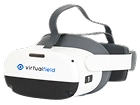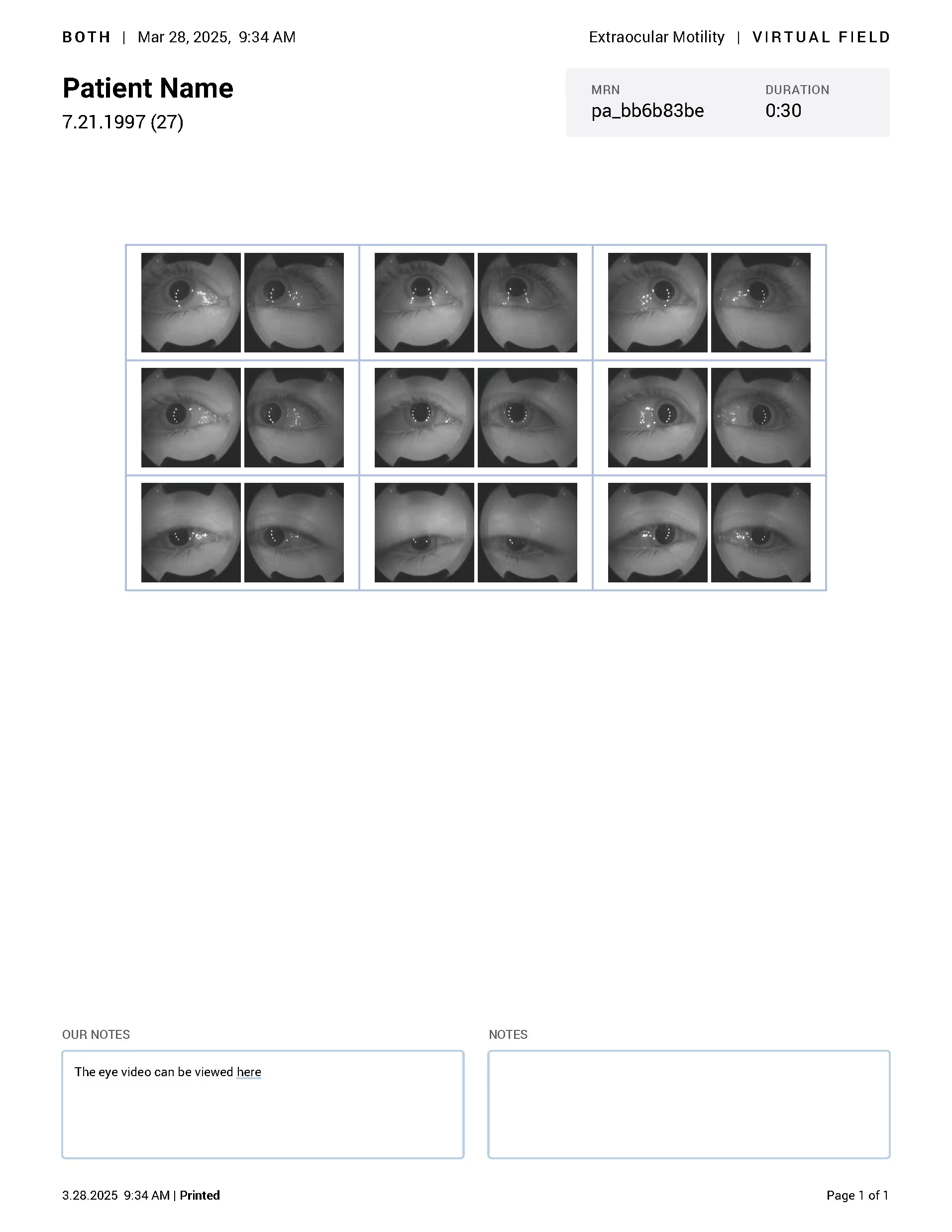Extraocular motility, or EOM, in eye exam lingo, refers to the muscular function of a patient’s eyes. Discoordination or unusual movements of the six extraocular muscles can reveal strabismus, nystagmus, or even point to underlying neurological conditions.
Extraocular motility testing is simple. Traditionally, this exam is performed with a penlight to observe the patient’s eye movements as they follow the light. This method is straightforward but doesn’t accurately measure subtle abnormalities. Moving this exam to Virtual Field’s virtual motility tool — a portable EOM testing device with real-time eye tracking—adds a pinpoint-accurate moving stimulus. Video and still images provide a clear, objective record for more accurate and efficient testing.
Extraocular Motility Exam Overview
Extraocular motility testing is a standard part of almost any comprehensive eye exam and the cornerstone of extraocular motility assessment. Moving a stimulus in an H-shaped pattern measures eye movement in up, down, left, right, and diagonal directions. The eye muscles’ movements are considered yoked to maintain coordinated vision, and if a patient’s gaze is uncoordinated or strained, this can signal weakened muscles. Any disruption in extraocular muscle function can lead to misalignment of the eyes, compromising stereopsis and depth perception.
This exam is typically performed manually with a light or even a finger, but modern diagnostic tools, specifically a portal EOM test platform, allow you to improve patient throughput without losing sight of accuracy. Virtual Field’s eye tracking–based eye-movement evaluation equipment removes the subjectivity that comes with traditional EOM testing methods. The stimulus is always correctly positioned, and even slight eye movements are trackable with our high-accuracy headset.
Academic references and clinical validation
The American Academy of Ophthalmology published a review on strabismus following extraocular muscle trauma. This resource emphasizes the importance of thorough extraocular motility testing to diagnose traumatic strabismus, which can result from injury.
A 2021 study introduced a novel laser pointer technique for measuring ocular duction ranges. The researchers found this method was reproducible, accurate, and simple. They concluded that this technique, similar to Virtual Field, could be valuable for evaluating patients with ocular motility disorders.
Video-oculography, or digital eye tracking technology, is a useful, objective way to test extraocular muscle function and collect objective measurements. This functionality is especially beneficial for myasthenia gravis patients.
Did you know? Virtual Field is the most widely used virtual visual field machine in the United States and Canada.

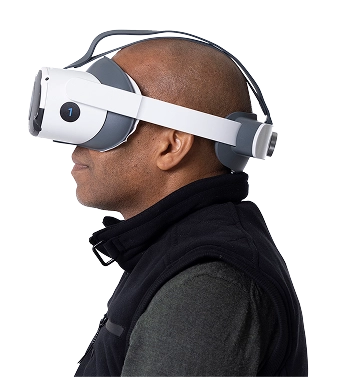
30 days free.
No strings attached.
We are confident you’ll love Virtual Field just like the 2,000 doctors who have already made the switch.
The Portable EOM Test at a Glance
The extraocular motility exam is a straightforward process — patients must follow an H-shaped pattern with their eyes while you assess their muscular function. You can conduct the exam without tools, but accuracy will be lost. This test can detect misalignments and specific conditions that may not be apparent with other visual tests. EOM is a standard eye exam component, but it is not individually billable.
Pros and cons of eye-movement evaluation equipment
We know the EOM exam is a trusted diagnostic test leveraged by many providers, but there are pros and cons to this exam that dictate when it's ideally used.
Pros
A lightweight, eom testing device lets you run the test chair-side or in any room.
This exam is almost always quick, painless, and simple to administer.
Extraocular motility exams have high diagnostic value, especially considering how simple and non-invasive this test procedure is.
With Virtual Field, this test is precise and objective, with clear-cut results.
Cons
Extraocular motility measurements without dedicated eye-movement evaluation equipment can be subjective and provide unreliable results.
Traditional testing methods can miss subtle abnormalities.
Testing requires full patient cooperation, which can be challenging for patients who are anxious, uncomfortable, or struggle to maintain focus.
List of Ocular Diseases Monitored and Diagnoses Identified by the Extraocular Motility Exam
This extraocular motility assessment helps diagnose or monitor:
Strabismus and Amblyopia
About 4% of adults have misalignment of the eyes, including esotropia, exotropia, hypertropia, and hypotropia. Strabismus isn’t always immediately visible, but you can reveal most cases with an extraocular motility test.
Nystagmus
This involuntary, repetitive eye movement can indicate neurological disorders, vestibular dysfunction, or drug toxicity. An accurate extraocular motility exam helps detect subtle nystagmus.
Myasthenia Gravis
This neuromuscular disorder causes fluctuating weakness in extraocular muscles, leading to ptosis and variable diplopia. You can use extraocular motility testing to inform patient referrals.

~1M
Americans have TED
5X
Women are 5X more likely to develop TED than men
Cranial Nerve Palsies
Specifically, damage to cranial nerves III (oculomotor), IV (trochlear), or VI (abducens) can cause restricted eye movement, double vision, and abnormal head positioning. The EOM test helps identify which nerve is affected based on the pattern of weakness.
Neurological Conditions
Multiple sclerosis has many eye-related symptoms that can be monitored with comprehensive eye testing. Demyelination in the central nervous system can affect eye movement control.
Thyroid Eye Disease (TED)
Autoimmune inflammation affects the extraocular muscles, leading to proptosis, restricted eye movement, and diplopia. You can track thyroid eye disease progression and assess muscle involvement with extraocular motility testing.
Other Conditions
The extraocular motility exam can also monitor:
- Orbital fractures
- Stroke
- Brain tumors
- Parinaud syndrome
Example EOM Report
30 days free.
No strings attached.
We are confident you’ll love Virtual Field just like the 2,000 doctors who have already made the switch.
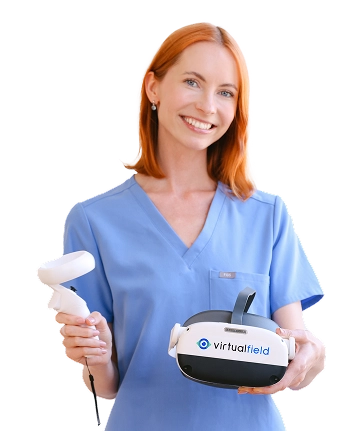
Extraocular Motility Exam Device | Buy Options
and Pricing
When researching extraocular motility exam device buy options, you’ll see a steep price vs. technology curve.
A basic penlight or fixation target costs just $7–$20 but offers only a subjective glimpse of eye-muscle function. A Maddox rod/occluder kit is another low-tech option, costing roughly $20–$50, that combines tools to add phoria measurement but remains manual and lighting-dependent.
Taking a step up in capabilities, tabletop synoptophores provide comprehensive binocular analysis. An economy import starts at around $673, while branded clinical units and marketplace listings range from $2,900 to $4,500. If you want objective video records, infrared video-oculography (VOG) goggles, such as the Insight Pro+, retail for about $2,600.
Representing the most comprehensive, modern, and positive ROI technology options, Virtual Field's VF3 Pro offers a VR headset with pinpoint eye tracking, automated stimuli, and instant video documentation starting at a predictable monthly subscription cost of $359. There’s no bulky hardware to house and no maintenance contracts to sign. Whether you’re upgrading from a $20 pen-light or replacing a $3,000 synoptophore, Virtual Field supplies synoptophore-level objectivity and VOG-quality video at a fraction of the upfront cost, making it the most innovative way to modernize extraocular motility testing.
Billing and Coding for EOM Assessment
The extraocular motility exam is not an independently billable test. However, it can be included as one of the four exams required for billing under CPT code 92060, which covers sensorimotor examination with multiple measurements of ocular alignment and motility.
When is the extraocular motility exam required?
The extraocular motility exam is a routine part of eye care, but it’s especially important for patients at risk of eye movement disorders. If a patient reports double vision, eye strain, or trouble tracking moving objects, EOM testing can help uncover the underlying issue. It’s also a key exam for those with a history of neurological conditions, head trauma, or systemic diseases like thyroid eye disease and myasthenia gravis.
Is the EOM test required for driver’s licenses?
No, an extraocular motility exam isn’t required for a driver’s license, but that doesn’t mean it’s not relevant. Poor eye movement control can make it harder to scan the road, judge distances, or react quickly to hazards. Patients with conditions like strabismus, cranial nerve palsies, or orbital trauma may have trouble with stereopsis and depth perception. Standard driver’s licensing vision tests, like the Esterman exam or FullField 120, are usually sufficient.
Start Conducting Extraocular Motility Exams with the Virtual Field Virtual Motility Tool
The extraocular motility exam gives a clear picture of how well the eyes move and work together. Patients with conditions like stroke or multiple sclerosis benefit from routine testing to catch changes in their eye movement early. For those with strabismus, this exam helps measure deficiencies and inform a treatment plan.
With Virtual Field’s advanced eye-tracking capabilities, EOM testing is faster, more precise, and completely objective to eliminate manual assessments. The controlled stimulus ensures accurate measurements, and if you’re already using Virtual Field’s VF3 Pro for other tests, adding this test to your routine is effortless.
Want all 23 exam guides in one place?
Download our comprehensive guide for 160+ pages of insights.
FAQs
1. Which cranial-nerve palsies can a digital EOM test detect?
2. How is range of motion quantified in the headset?
3. Does EOM testing require pupil dilation or dark room?
4. What is the average test time for a full EOM assessment?
5. How are findings exported to the EMR?
6. Can the EOM test monitor thyroid eye disease progression?
Ready to get started?
Schedule a demo or begin your 30-day free trial of Virtual Field to try our EOM exam in your practice.
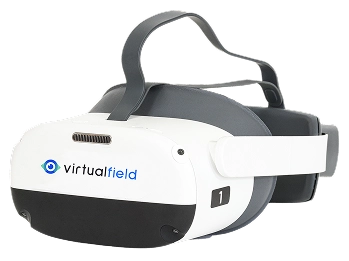
Questions? Contact sales@virtualfield.io talk to a Virtual Field expert today.

